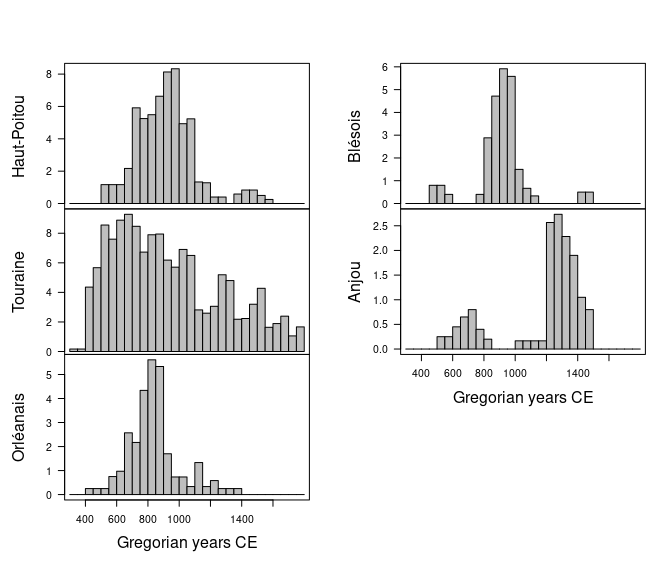A toolkit for relative and absolute dating and analysis of
chronological patterns. This package includes functions for
chronological modeling and dating of archaeological assemblages from
count data. It provides methods for matrix seriation. It also allows to
compute time point estimates and density estimates of the occupation and
duration of an archaeological site. kairos provides
methods for:
This package provides translations of user-facing communications,
like messages, warnings and errors, and graphical elements (axis
labels). The preferred language is by default taken from the locale.
This can be overridden by setting of the environment variable
LANGUAGE (you only need to do this once per session):
Baxter, M. J., and H. E. M. Cool. 2016. “Reinventing the Wheel?
Modelling Temporal Uncertainty with Applications to Brooch Distributions
in Roman Britain.”
Journal of Archaeological Science 66:
120–27.
https://doi.org/10.1016/j.jas.2015.12.007.
Bellanger, L., and P. Husi. 2012. “Statistical Tool for Dating and
Interpreting Archaeological Contexts Using Pottery.”
Journal of
Archaeological Science 39 (4): 777–90.
https://doi.org/10.1016/j.jas.2011.06.031.
———. 2013. “Mesurer et modéliser le temps inscrit dans la matière à
partir d’une source matérielle : la céramique médiévale.” In Mesure
et histoire médiévale, 119–34. Histoire ancienne et médiévale.
Paris: Publication de la Sorbonne.
Bellanger, L., P. Husi, and R. Tomassone. 2006a. “Statistical Aspects of
Pottery Quantification for the Dating of Some Archaeological Contexts.”
Archaeometry 48 (1): 169–83.
https://doi.org/10.1111/j.1475-4754.2006.00249.x.
———. 2006b. “Une approche statistique pour la datation de contextes
archéologiques.”
Revue de statistique appliquée 54 (2): 65–81.
https://www.numdam.org/item/RSA_2006__54_2_65_0/.
Bellanger, L., R. Tomassone, and P. Husi. 2008. “A Statistical Approach
for Dating Archaeological Contexts.” Journal of Data Science 6:
135–54.
Brainerd, G. W. 1951. “The Place of Chronological Ordering in
Archaeological Analysis.”
American Antiquity 16 (4): 301–13.
https://doi.org/10.2307/276979.
Colman, S. M., K. Pierce, and P. W. Birkeland. 1987. “Suggested
Terminology for Quaternary Dating Methods.”
Quaternary Research
28 (2): 314–19.
https://doi.org/10.1016/0033-5894(87)90070-6.
Crema, E. R. 2012. “Modelling Temporal Uncertainty in Archaeological
Analysis.”
Journal of Archaeological Method and Theory 19 (3):
440–61.
https://doi.org/10.1007/s10816-011-9122-3.
Crema, E. R., A. Kandler, and S. Shennan. 2016. “Revealing Patterns of
Cultural Transmission from Frequency Data: Equilibrium and
Non-Equilibrium Assumptions.”
Scientific Reports 6 (1).
https://doi.org/10.1038/srep39122.
Dean, J. S. 1978. “Independent Dating in Archaeological Analysis.” In
Advances in Archaeological Method and Theory, 223–55. Elsevier.
https://doi.org/10.1016/B978-0-12-003101-6.50013-5.
Desachy, B. 2004. “Le sériographe EPPM: un outil informatisé de
sériation graphique pour tableaux de comptages.”
Revue archéologique
de Picardie 3 (1): 39–56.
https://doi.org/10.3406/pica.2004.2396.
Dunnell, R. C. 1970. “Seriation Method and Its Evaluation.”
American
Antiquity 35 (3): 305–19.
https://doi.org/10.2307/278341.
Dye, T. S. 2016. “Long-Term Rhythms in the Development of Hawaiian
Social Stratification.”
Journal of Archaeological Science 71:
1–9.
https://doi.org/10.1016/j.jas.2016.05.006.
Feder, A. F., S. Kryazhimskiy, and J. B. Plotkin. 2014. “Identifying
Signatures of Selection in Genetic Time Series.”
Genetics 196
(2): 509–22.
https://doi.org/10.1534/genetics.113.158220.
Ihm, P. 2005. “A Contribution to the History of Seriation in
Archaeology.” In
Classification – the Ubiquitous Challenge,
edited by C. Weihs and W. Gaul, 307–16. Berlin Heidelberg: Springer.
https://doi.org/10.1007/3-540-28084-7_34.
Johnson, I. 2004. “Aoristic Analysis: Seeds of a New Approach to Mapping
Archaeological Distributions Through Time.” In Enter the Past -
The E-way into the Four Dimensions of
Cultural Heritage, edited by K. F. Ausserer, W. Börner, M. Goriany,
and L. Karlhuber-Vöckl, 448–52. BAR International Series 1227. Oxford:
Archaeopress.
Kintigh, K. 2006. “Ceramic Dating and Type Associations.” In
Managing Archaeological Data: Essays in Honor of Sylvia W.
Gaines, edited by J. Hantman and R. Most, 17–26. Anthropological
Research Paper 57. Tempe, AZ: Arizona State University.
https://doi.org/10.6067/XCV8J38QSS.
Lipo, C. P., M. E. Madsen, and R. C. Dunnell. 2015. “A
Theoretically-Sufficient and Computationally-Practical Technique for
Deterministic Frequency Seriation.”
PLOS ONE 10 (4): e0124942.
https://doi.org/10.1371/journal.pone.0124942.
Müller-Scheeßel, N., and M. Hinz. 2018. “Aoristic Research in R:
Correcting Temporal Categorizations in Archaeology.” Presented at the
Human History and Digital Future (CAA 2018), Tubingen, March 21.
https://www.youtube.com/watch?v=bUBukex30QI.
O’Brien, M. J., and R. L. Lyman. 2002. Seriation, Stratigraphy, and
Index Fossils: The Backbone of Archaeological Dating. Dordrecht:
Springer.
Orton, D., J. Morris, and A. Pipe. 2017. “Catch Per Unit Research
Effort: Sampling Intensity, Chronological Uncertainty, and the Onset of
Marine Fish Consumption in Historic London.”
Open Quaternary 3:
1.
https://doi.org/10.5334/oq.29.
Palmisano, A., A. Bevan, and S. Shennan. 2017. “Comparing Archaeological
Proxies for Long-Term Population Patterns: An Example from Central
Italy.”
Journal of Archaeological Science 87: 59–72.
https://doi.org/10.1016/j.jas.2017.10.001.
Peeples, M. A., and G. Schachner. 2012. “Refining Correspondence
Analysis-Based Ceramic Seriation of Regional Data Sets.”
Journal of
Archaeological Science 39 (8): 2818–27.
https://doi.org/10.1016/j.jas.2012.04.040.
Petrie, W. M. F. 1899. “Sequences in Prehistoric Remains.”
Journal
of the Anthropological Institute of Great Britain and Ireland 29
(3/4): 295–301.
https://doi.org/10.2307/2843012.
Philippe, A., and M.-A. Vibet. 2020. “Analysis of Archaeological Phases
Using the R Package ArchaeoPhases.”
Journal of Statistical
Software 93.
https://doi.org/10.18637/jss.v093.c01.
Poblome, J., and P. J. F. Groenen. 2003. “Constrained Correspondence
Analysis for Seriation of Sagalassos Tablewares.” In The Digital
Heritage of Archaeology, edited by M. Doerr and A. Sarris. Athens:
Hellenic Ministry of Culture.
Porčić, M. 2013. “The Goodness of Fit and Statistical Significance of
Seriation Solutions.”
Journal of Archaeological Science 40
(12): 4552–59.
https://doi.org/10.1016/j.jas.2013.07.013.
Ratcliffe, J. H. 2000. “Aoristic Analysis: The Spatial Interpretation of
Unspecific Temporal Events.”
International Journal of Geographical
Information Science 14 (7): 669–79.
https://doi.org/10.1080/136588100424963.
———. 2002. “Aoristic Signatures and the Spatio-Temporal Analysis of High
Volume Crime Patterns.”
Journal of Quantitative Criminology 18
(1): 23–43.
https://doi.org/10.1023/A:1013240828824.
Roberts, J. M., B. J. Mills, J. J. Clark, W. R. Haas, D. L. Huntley, and
M. A. Trowbridge. 2012. “A Method for Chronological Apportioning of
Ceramic Assemblages.”
Journal of Archaeological Science 39 (5):
1513–20.
https://doi.org/10.1016/j.jas.2011.12.022.
Robinson, W. S. 1951. “A Method for Chronologically Ordering
Archaeological Deposits.”
American Antiquity 16 (4): 293–301.
https://doi.org/10.2307/276978.
South, S. A. 1977. Method and Theory in Historical Archaeology.
Studies in Archeology. New York: Academic Press.
Velden, M. vande, P. J. F. Groenen, and J. Poblome. 2009. “Seriation by
Constrained Correspondence Analysis: A Simulation Study.”
Computational Statistics & Data Analysis 53 (8): 3129–38.
https://doi.org/10.1016/j.csda.2008.08.020.



